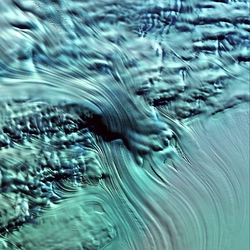The albedo of the Earth is 0.367.
That’s the simple answer, now here’s the more complex one. Astronomers use the term “albedo” to define the amount of light that an object in the Solar System reflects. For example, if a planet was perfectly shiny, it would have an albedo of 1.00; it would reflect 100% of the light that hit it. If a planet was perfectly dark, it would have an albedo of 0, and so it would reflect 0% of the light that struck it.
The object with the highest albedo in the Solar System is Saturn’s moon Enceladus, with an albedo of 99%. On the other hand, asteroids can have albedos as low as 4%. The Earth’s moon has an albedo of about 7%. Can you imagine if we had Enceladus for a moon? Now that would be bright.
The albedo of the Earth is very important because it helps define the temperature of the planet. Fresh snow has an albedo of 90%, while the ocean has a very low albedo; land areas range from 0.1 to 0.4.
NASA’s Terra and Aqua satellites are constantly measuring the albedo of the Earth with their MODIS instruments, to help detect any evidence that the albedo is changing over time.
We have written many articles about the Earth for Universe Today. Here’s an article about how scientists track Earthshine on the Moon. And here’s a more detailed article about the albedo of the Moon.
Want more resources on the Earth? Here’s a link to NASA’s Human Spaceflight page, and here’s NASA’s Visible Earth.
We have also recorded an episode of Astronomy Cast about Earth, as part of our tour through the Solar System – Episode 51: Earth.

